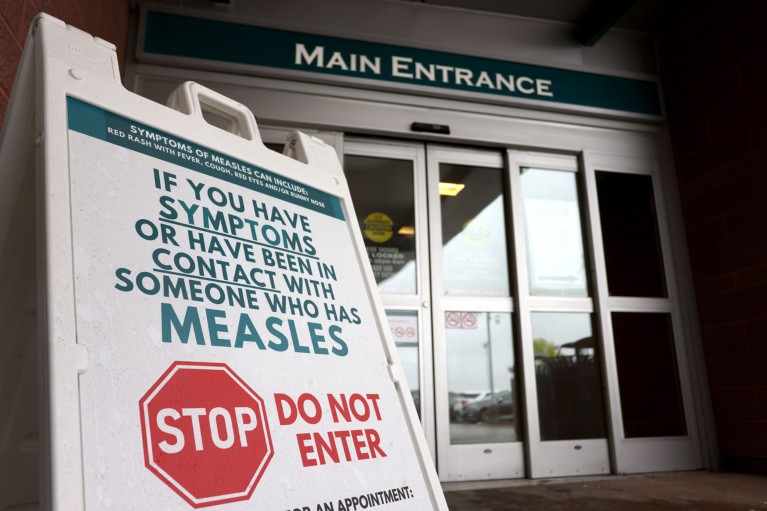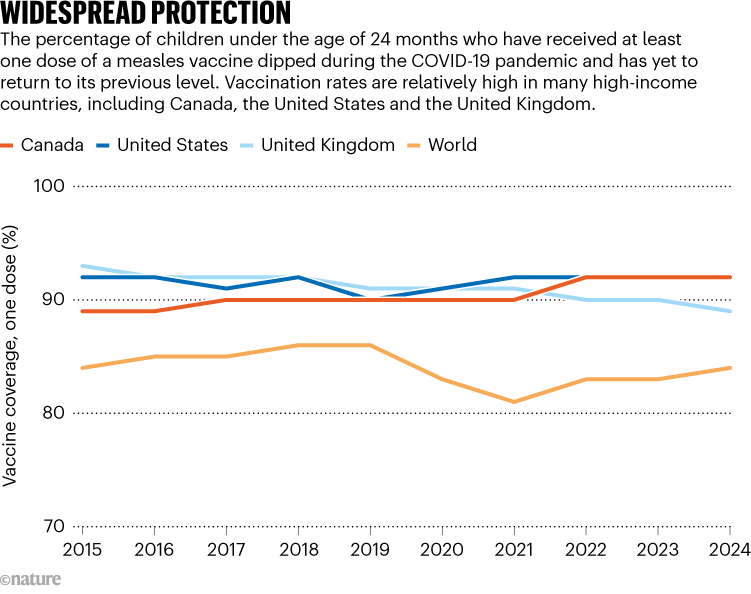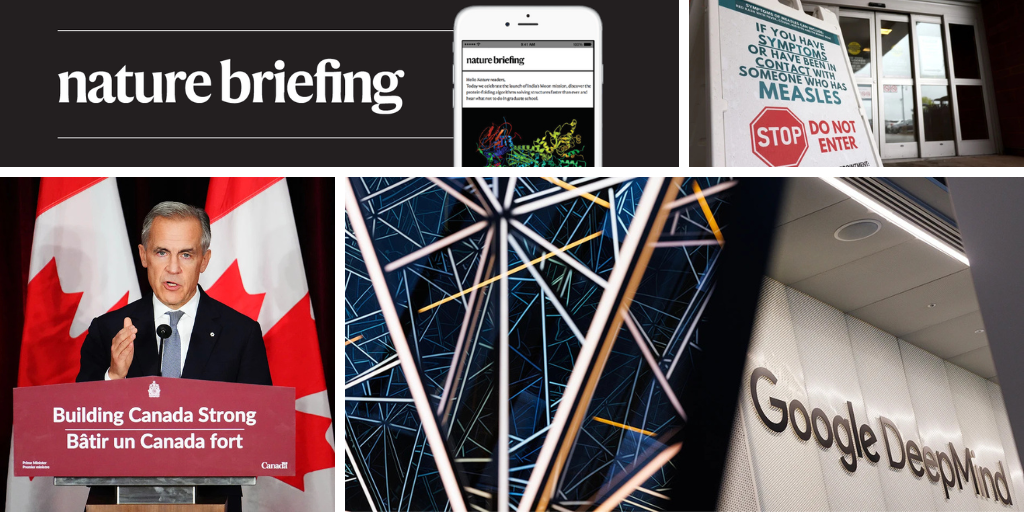You have full access to this article via your institution.
Hello Nature readers, would you like to get this Briefing in your inbox free every day? Sign up here.
People with measles are barred from entering a hospital in Canada, which has seen a surge in cases of the highly infectious disease in 2025.Credit: Nicole Osborne/The Canadian Press via ZUMA Press
Measles outbreaks in the United States and Canada could be a worrying sign of things to come, say public-health experts. “We tend to see measles outbreaks first, just because it’s so contagious,” says epidemiologist William Moss. The surge in North America follows one in Africa in 2019, and another in Europe in 2024. Vaccination rates in some places are declining, due in part to changing attitudes. This year has also seen cuts to foreign aid for vaccination programmes and a change in vaccination policies, particularly in the US — meaning that a resurgence of other diseases might be next.

Source: UNICEF
Most large apes kiss — defined as “a non-agonistic interaction involving directed, intraspecific, oral-oral contact with some movement of the lips/mouthparts and no food transfer” — and Neanderthals probably did too, according to a new analysis. Researchers combed the literature and YouTube — they admit these data are just “a starting point” — for observations of kissing in various species and used it to reconstruct the evolution of the act. “We think kissing probably evolved around 21.5 million years ago in the large apes,” says evolutionary biologist and study co-author Matilda Brindle. The question is, why? “We should be studying this behaviour, not just dismissing it as silly because it has romantic connotations in humans,” says Brindle.
Reference: Evolution and Human Behavior paper
Scientists in Canada gave a sigh of relief as the country’s federal budget mostly spared the country’s three main research-funding councils amid continuing economic fallout from tariffs instituted by the administration of US President Donald Trump. The nation also poured further investment into attracting international scientists from abroad: Can$1.7 billion (US$1.2 billion) over the next 13 years to attract more than 1,000 high-level international researchers to Canada.
However, “they are being welcomed to a system that is facing a funding crisis, where existing researchers are struggling,” says anthropologist Robin Whitaker, president of the Canadian Association of University Teachers. Those that proposed the talent-attraction plan agree: “Investments in talent attraction will be wasted if recruits to Canada start to look to other countries offering higher levels of funding for research,” write former governor general David Johnston, who was head of both McGill and Waterloo universities, former Prime Minister’s chief of staff Eddie Goldenberg and public-health researcher and academic leader Alan Bernstein.
Nature | 6 min read (part of Nature Spotlight: Canada), CBC | 4 min read & National Newswatch | 7 min read
Features & opinion
Last year, computer scientists Demis Hassabis and John Jumper — co-founder and now director of Google DeepMind, respectively — took home the Nobel Prize for creating AlphaFold, the artificial intelligence (AI) tool that revolutionized the prediction of protein structures. The tool wasn’t the first of DeepMind’s creations to make waves and, if Hassabis has anything to say about it, will not be the last. But the landscape of AI research has changed drastically since DeepMind arrived on the scene, and the need to accelerate has put a strain on the company’s ability to do so responsibly. This shift has some questioning where DeepMind is headed, and whether it can achieve blockbuster successes in other fields of science.
“Gross domestic product (GDP) was never designed to be a measure of societal well-being,” write five experts in global prosperity. GDP did the job as a reasonable proxy in the years after the Second World War, but now we sorely need a measure that takes into account aspects such as life expectancy, financial security and a healthy environment, argue the authors. They lay out a plan for breaking our ‘addiction’ to the current growth-driven system.
Rewiring Democracy, a new book by cybersecurity expert Bruce Schneier and data scientist Nathan Sanders, offers a framework for maximizing the democratic potential of AI that is “rich with concrete examples and absorbing speculation”, writes journalist and political scientist Virginia Eubanks. One such idea: a personal “army of AI minions” could extend individual power by making it easier to speak out. “Yet, by shrinking and distorting the vexing political challenges that the world faces today to fit a single solution — AI — they short-change the frustrating glories of living together as human beings,” writes Eubanks.
The world’s largest oil exporter is betting big on renewable energy — despite blocking global efforts to move away from fossil fuels. Saudi Arabia is set to more than double its new solar capacity this year. “No country is going faster,” says energy-transition analyst Dave Jones. “Solar is so cost competitive, it makes financial sense,” says energy-policy researcher Karen Young. And for the sun-rich country, using solar energy at home means more oil to sell abroad.
Today I’m celebrating World Anteater Day, not by eating ants, but by reading the beautiful explanation of the giant anteater’s (Myrmecophaga tridactyla) spectacularly odd jaw — written by Nature’s own Henry Gee in 1999. Here’s the related News & Views should you wish to go deeper. Or just skip to this delightful image of a giant anteater pup in last month’s collection of great science photos.
If you enjoy this newsletter, I’d be very grateful if you were to recommend it to a friend or colleague. Please click here to forward it by e-mail. Thank you!
Thanks for reading,
Flora Graham, senior editor, Nature Briefing
With contributions by Jacob Smith
• Nature Briefing: Careers — insights, advice and award-winning journalism to help you optimize your working life
• Nature Briefing: Microbiology — the most abundant living entities on our planet — microorganisms — and the role they play in health, the environment and food systems
• Nature Briefing: Anthropocene — climate change, biodiversity, sustainability and geoengineering
• Nature Briefing: AI & Robotics — 100% written by humans, of course
• Nature Briefing: Cancer — a weekly newsletter written with cancer researchers in mind
• Nature Briefing: Translational Research — covers biotechnology, drug discovery and pharma


